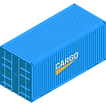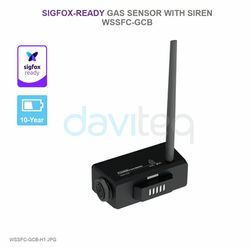Daviteq Technologies
SIGFOX
Sigfox is a global Low-Power Wide-Area Network (LPWAN) technology developed for simple and scalable IoT applications. It provides long-range communication with ultra-low power consumption and low cost, enabling devices to send small data packets reliably over long distances. With years of battery life, Sigfox is especially suited for battery-powered IoT sensors in applications such as asset tracking, smart metering, and remote monitoring.
How Does Sigfox Work?
Sigfox uses ultra-narrowband (UNB) modulation in the sub-GHz spectrum. Devices transmit very short messages (up to 12 bytes uplink, 8 bytes downlink) to nearby Sigfox base stations. These base stations forward the data to the Sigfox cloud, where it can be accessed by applications through APIs. The system is optimised for small, infrequent messages rather than continuous data streams, which keeps power consumption extremely low and devices simple.

Sigfox uses an ultra-narrowband (UNB) technology to connect low-power IoT devices over long distances. Here’s a simplified breakdown of how it works:
1. End Devices (Sensors & Nodes)
Simple IoT devices such as GPS trackers, temperature sensors, or smart meters transmit data at scheduled intervals using Sigfox’s UNB modulation. Example: a GPS tracker sending its location once every hour.
2. Base Stations
These stations receive the radio signals and forward them via IP, fiber, or cellular backhaul to ensure reliability. One base station can cover up to 30–50 km in urban areas and even more in rural zones.
3. Sigfox Cloud™
The intelligence of the network—authenticating messages, filtering duplicates, and routing data securely to customer applications. It also offers APIs and protocols (HTTP, MQTT) for easy integration into existing systems.
4. Applications
Data becomes actionable through dashboards, alerts, and automation. Companies can track containers across borders, monitor utility meters remotely, or protect valuable assets with real-time visibility.

Sigfox Key Features
Long range coverage
Up to 15–20 km in rural areas, 2–5 km in urban areas
Ultra-low power consumption
Devices can operate 5–10 years on a single battery - ideal for remote monitoring
Ideal for outdoor tracking
Wide-area network coverage makes it easy to track moving objects across cities, fields, or remote regions
Low operating cost
No heavy monthly data fees, helping reduce total IoT ownership cost
Supports a large number of devices
Thousands of nodes per gateway allow for massive IoT rollouts
Low bandwidth
Data rates from only 0.3 kbps to 50 kbps, not suitable for large data volumes
Not suitable for high-speed mobility
Optimized for stationary or slow-moving devices
High latency
Not suitable for applications requiring real-time response
Limited by Sigfox provider
Operation depends on Sigfox’s infrastructure, which may limit flexibility in some areas

Sigfox Applications
Asset Tracking

Reliable, low-power connectivity for monitoring containers, fleets, and high-value goods. Devices can report location over long distances while running for years on a single battery—improving global logistics efficiency and supply chain visibility.

Ideal for water, gas, and electricity providers. Sigfox enables meters to send small data packets at scheduled intervals, supporting remote monitoring, reducing manual readings, and cutting operational costs.
Security & Alerts

Enables instant notifications for intrusion detection, panic buttons, and environmental safety alerts. With wide coverage and long battery life, Sigfox ensures reliable communication even under critical conditions.
Sigfox & Other Connectivities
Title |
|---|
Coverage Range |
Data Rate |
Power Consumption |
Device/ Service Cost |
Required Infrastructure |
Typical Applications |
Sigfox | LoRaWAN | Sub-1GHz | NB-IoT |
|---|---|---|---|
3–10 km (urban), 30–50 km (rural) | 2–15 km (urban), 15–40 km (rural) | 1–10 km | 1–10 km (excellent indoor penetration) |
100 bps uplink, 600 bps downlink | 0.3–50 kbps | Several kbps to hundreds of kbps | 26–250 kbps |
Very low | Very low | Very low | Low to medium |
Low (subscription-based) | Low | Low | Medium (IoT SIM) |
Sigfox network | Private gateways or public LoRaWAN network | Self-deployed network | NB-IoT mobile network |
Low-cost asset tracking, utility meters, simple low-cost sensors, simple alarm & monitoring systems | Smart factory, smart agriculture, smart cities, smart building, logistics tracking | Warehouse monitoring, environment monitoring, industrial monitoring and control | Smart meters, environmental monitoring, smart parking, healthcare devices, logistics tracking |
Daviteq Sigfox Sensors & Actuators
Daviteq designs and manufactures a full range of Sigfox-certified wireless sensors and actuators, built for long-lasting and reliable IoT applications. Key features include:
-
Using a Sigfox-certified RF module for global connectivity
-
Ultra-low power design with up to 10-year battery life (2 × AA Alkaline or Lithium) → reducing maintenance costs
-
Support for all Sigfox RC Zones worldwide
-
Options for internal or external antennas, and solar harvesting with 10-year lifetime
-
Rugged design with IP67/68 protection for indoor and outdoor use
-
Ex d approved for hazardous zones (1-2-21-22)
-
Certified to international standards (CE/FCC compliance)
-
Seamless integration with 100+ sensor types: temperature, humidity, pressure, level, vibration, CO₂, CO, NH₃, Cl₂, H₂S...
These capabilities make Daviteq Sigfox sensors and actuators ideal for applications in industrial IoT, smart agriculture, logistics, and environmental monitoring.
 |  |  |
|---|
Sigfox Sensors & Actuators
Resources
Frequently Asked Questions
Find quick answers to common questions about wireless connectivity, compatibility, and how to choose the right technology for your IoT deployment.
Which is better, Sigfox or LoRa?
Sigfox is a subscription-based global network, simple to deploy and optimised for long battery life and low-cost IoT. LoRa offers flexibility for private networks but requires investment in gateways and infrastructure. The choice depends on use case: Sigfox suits global, low-maintenance deployments, while LoRa fits private, customizable projects.
Is Sigfox still available?
Yes, Sigfox technology is still available. After going into receivership in 2022, Sigfox was acquired by UnaBiz, an IoT company based in Singapore and Taiwan. Under this new management, Sigfox continues to operate its global 0G network, while restructuring to ensure long-term sustainability.
What is the maximum uplink message quantity and the payload size on Sigfox?
Each Sigfox device can send up to 140 uplink messages per day, with each message carrying a maximum payload size of 12 bytes. This limitation is designed to optimise battery life and ensure efficient use of the ultra-narrowband network.
Can Sigfox be jammed?
Sigfox uses ultra-narrowband (UNB) modulation in the sub-GHz spectrum, making it resistant to interference and difficult to jam. Its signals can be received by multiple base stations at once, which adds redundancy and increases communication reliability even in noisy environments.
Got more questions?
50+ choices





